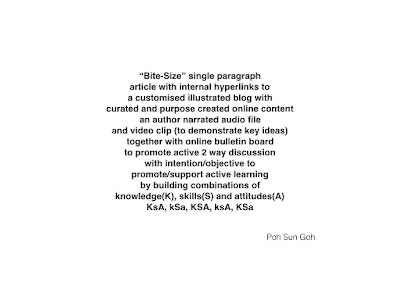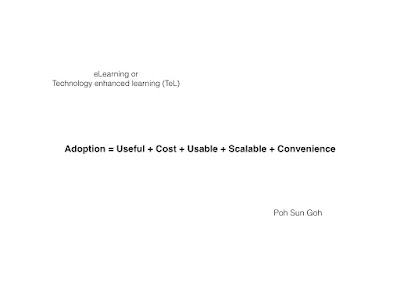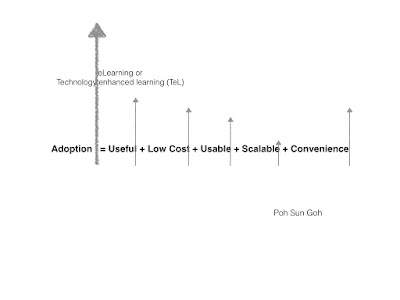Goh, P.S. eLearning in Medical Education - Costs and Value add (published 2 May 2018)
"eLearning, or Technology enhanced learning (learning enhanced by use of the web/online through mobile devices, accessing digital content, and promoting learning activities and interactive learning through software and Apps), like any teaching aid or tool, need not be used if all the optimal conditions for teaching and learning exists in a traditional, bricks and mortar classroom, and there is no need to extend the educational reach of the teacher, or interaction with the student, beyond a single classroom encounter - with no necessity to engage and interact before or after class."
Poh Sun (20 March 2017 @ 4am, first shared with participants at 14th APMEC 2017; and with educational team at NUS Dentistry on 3 March 2017).
"these "optimal conditions for traditional classroom learning" include having a skilled teacher available, fully present, rested, not interrupted (by phone calls - consultation requests or text - WhatsApp messages), in peak physical health (not unwell, jet lagged, sleep deprived); interacting with a class who are all present, fully engaged, in peak physical condition (not unwell, jet lagged, sleep deprived, not available to attend due to personal or other work commitments (running ward or clinic), not interrupted, not called away); and with students not required, and who do not require to pause a presentation-presentation or discussion narrative or process, reply to a point; and with all students able to ask questions as and when required by interrupting the presenter-teacher."
Poh Sun (20 March 2017 @ 4am, first shared with participants at 14th APMEC 2017; and with educational team at NUS Dentistry on 3 March 2017).
"but if you want to extend and expand the "classroom", and contact with students, before - during - and after class; to offer (all) students the ability of make points, and pose questions at the same time, and synchronously with the "live" presentation; to share and make accessible learning-educational content (for pre-reading) before class; and further reading-review after class; and for reference during class (recommended reading-resource material; not just material that students search for themselves) ... if you (as the teacher), want to make the learning "recipe", the learning and engagement process visible and transparent, not only for peer review-self review/reflection/evaluation for improvement, but also to allow students to revisit not only the content and interactive learning activities, but also review and reflect on the learning and engagement process ... and learn from this ... then presenting directly and through an online platform, with embedded engagement and interactive spaces and tools aids the digitally enabled teacher, and learner; not to replace traditional teaching and learning, in the physical classroom, with traditional methods and tools, but to enable, enhance, extend, expand teaching and learning opportunities and activities."
Poh Sun (20 March 2017 @ 4am, first shared with participants at 14th APMEC 2017; and with educational team at NUS Dentistry on 3 March 2017).
Abstract
This article (and its accompanying and complementary presentation blog) expands on ideas presented and elaborated on during the pre-conference workshop, and main conference symposium on this topic at 14th APMEC. It will specifically address the issue of the costs involved, and value add of eLearning. It is presented in a single paragraph (below), augmented by internal keyword links to additional resources, links to the original workshop and symposium presentation blogs, an audio podcast, video(example 1) or video (example 1, embedded version below) demonstration, and interactive online bulletin board.
Note to participants
There is way too much material on this "presentation" blog to be reviewed, or viewed "live" during the actual session. This is why the material has been shared with you beforehand. As with any "buffet", it is not recommended, or possible, to review, "consume" or digest all the material in one sitting.
Recommend you use this blog as a "buffet" spread. Suggest you review the "one paragraph" overview, screenshot with highlighted passage above, and then view and review the material on this blog according to your interest, over several short sessions, before coming to the Friday presentation and interactive discussion.
See you all this coming Friday!
With warm regards,
Poh Sun
https://padlet.com/dnrgohps/practicalTipsToUseTeL#
"We adopt, and use often, what is easily accessible, available, at hand, easy to use, useful, usable, modular, low cost/free to use/open access (with attribution), often but not exclusively in digital form or online; either content, process, educational solution, or platform."
Poh Sun (16 January 2017 @ 0900am)
"technology has also enabled institutions like IMD to "reach deeper into an organisation, and also more widely across the world", as well as "customise the learning journeys more than before" ...
"Course modules can also be designed so that "if you want to know more about this you're gonna click here, and there... that will enable you to choose which parts you're more interested in" ...
"the technology is allowing us to access more people more often. So that's fantastic; it means we can have a more sustainable impact because we work with them for longer." ...
to deliver ... "real learning with impact"
IMD president Jean-Francois Manzoni (in The Raffles Conversation, The Business Times, Saturday, 18 February 2017)
"I don't think technology on its own is the driver, it's the focus on customer experience that is the driver. Technology is the facilitator and I would say it's the transformation of the customer experience that is being facilitated by technology ... It's a subtle difference but an important one as otherwise you could be building technology for technology's sake ... I'm interested in what the technology can do more than I'm interested in how it works ... I mean, yes, I need to understand to some degree how it works. But what really excites me and I get passionate about is what the technology can do ... I think if you apply that thinking of what can it do and understand that, then if you have some very capable people around you who understand how you can make the technology work and what the boundaries are, then you have a winning combination."
Telstra CEO Andrew Penn (in The Raffles Conversation, The Business Times, Saturday, 25 February 2017)
"I think it (technology) is a natural area where we do have an advantage because we are a city, we are compact and we are wired up. It is economical for us to provide very high-quality infrastructure, and we have people who take to it naturally.
Individually, they know how to operate their phones or play Starcraft, Warcraft. But also, I think as a nation, our ethos is one where we are rationalist. If it makes sense, if it can be done more efficiently, if I can short-circuit the process and cut out the to-ing and fro-ing, I will want to do that. People will support that."
PM Lee Hsien Loong (in The Straits Times, Tuesday, 28 February 2017)
"education and learning need to be lifelong ... adult training needs to be bite-sized, relevant, concise, convenient, and to the point ... impart skills, not just information and knowledge ... because information can be "Googled", skills cannot ... (transform our higher education to focus on) learning by doing ... underlined (by) centuries of European apprenticeship and craftsmanship ... adapt to a data-rich and digital working environment ... (be) data-enabled as a workforce ..."
Ong Ye Kung, Minister for Education (Higher Education and Skills) in speech to Parliament, delivered on Tuesday, March 7th, 2017 and reported in The Straits Times, Thursday, 9 March, 2017).
screenshot above from website below
screenshot above from website below
http://www.tiki-toki.com/timeline/entry/64373/History-of-Educational-Technology/#vars!date=0184 BC-12-02_03:10:43!http://www.tonybates.ca/2014/12/10/a-short-history-of-educational-technology/
https://opentextbc.ca/teachinginadigitalage/
Personal View
eLearning or Technology enhanced learning leverages on the exponential increase in internet use, connecting a local and global audience, increasingly through mobile technologies, which put the internet into our pocket, or purse, giving access to information and learning opportunities on demand, at a time and place customised to an individual learners needs, yet scaling up easily to a whole class, cohort, or global interest group; assisting teachers to expand and extend learning and interactive, active discussion and engagement beyond the physical classroom, and increase contact time with learning material and activities, not only before, during and after scheduled "class-time"; to support ongoing learning and training from undergraduate, through postgraduate, to lifelong learning and continuing professional development; taking individual students from novices, through competency and proficiency, to expert level performance and mastery. The costs in time and effort are greatly reduced by a concerted ongoing effort to systematically create, collect and curate (with attribution) useful, usable and (high) quality educational and training material in digital form (content) which is indexed and hyperlinked accessible for immediate use (on demand, as required, within digital repositories); the use of low cost and free online tools and platforms, like Blogger, Padlet and Instagram, used exclusively for professional training purposes, following best practices, local and international guidelines and rules governing professionalism, protecting privacy, and respecting intellectual property. The focus is always on the quality, usability and usefulness of content (first), and our instructional purpose/learning objectives, our pedagogical intention, before searching for the lowest cost, easiest to use, and most accessible technological solution, supported by best practices (empirical based and supported by the literature) in instructional design. These instructional practices may not use any technology at all, or time tested "old-school" tech of microphones, paper and pen, chalk and a blackboard; or their online digital versions. TeL adds value by helping students, teachers, and administrators/funding agencies/parents "see what we actually teach with, and assess on", and makes the learning process and outcomes visible and increasingly measurable, through data analysis and data analytics (see tip 10 on linked article). Scholarly teaching, and educational scholarship can also be promoted through the use of online digital portfolios, making our efforts as educators visible, accessible, and assessable; for colleagues and peers to critique, give feedback on, and add to our work. To sum up, technology can augment, amplify, enhance, expand and extend our educational efforts as teachers, making useful content accessible; and assisting active learning activities which when done online are easily visible, as well as accessible for more rapid feedback and review. Making regular, incremental efforts to add to our educational content, and refine our learning processes is not only low cost, but also cost effective, particularly when low cost or free online tools and platforms are used skilfully and thoughtfully by teachers with a strong foundation of pedagogical knowledge and understanding of the theory and practice of instructional design; working with an ever increasing repertoire and repository of reusable digital content and teaching plans; which are made easily available for a teacher, as well as a larger teaching community to use through an indexed, peer and user reviewed, online digital repository; where not only highly viewed, rated, cited to, linked to, and downloaded material; but also all potential usable and useful material is visible, and accessible; to be used, reused, repurposed, and added to.
Journal article/Book .......... Physical copy/online ......... Hyperlinked Blog Post ....... Multimedia Webpage ......... Infographic ............... ePoster ............ Instagram .............. VR/AR/MR
Poh Sun (16 January 2017 @ 0900am)
Everything I have learnt about eLearning from Poh-Sun Goh
https://medicaleducationelearning.blogspot.sg/2016/12/my-elearning-journey.html
https://medicaleducationelearning.blogspot.sg/2016/12/my-elearning-journey.html
Medical Education Peer Reviewed Publications (selected)
The intention of writing a recent series of reflection pieces (article 5, 6, 7, 9 and 11), as well the other articles below, was to set down in print as many of the useful ideas / and pointers I could think of, and which I have found useful and currently use, on the subject of TeL and implementing this, distilled from my reading, practice, and scholarly inquiry since 2002, as well as from the last 6 years of faculty development presentations, symposia and workshops I have been involved in designing and have participated in at NUS, at APMEC and AMEE; and have presented as invited speaker to conferences in Colombo, Sri Lanka; Kaohsiung, Taiwan; Jakarta, Indonesia; and as visiting professor in Almaty, Kazakhstan.
(articles in Medical Teacher and MedEdPublish have been viewed over 5,000 times in the 2015 and 2016, and papers 1, 3, 4 and 5 are amongst the top rated papers in Oct, Nov, Dec 2016 and Jan 2017 - see below)
1. Goh, P.S. Learning Analytics in Medical Education. MedEdPublish. 2017 Apr; 6(2), Paper No:5. Epub 2017 Apr 4. HTTPS://DOI.ORG/10.15694/MEP.2017.000067
2. Goh, P.S., Sandars, J. Insights from the culinary arts for medical educators. MedEdPublish. 2017 Jan; 6(1), Paper No:10. Epub 2017 Jan 18.
3. Goh, P.S. A proposal for a grading and ranking method as the first step toward developing a scoring system to measure the value and impact of viewership of online material in medical education - going beyond “clicks” and views toward learning. MedEdPublish. 2016 Oct; 5(3), Paper No:62. Epub 2016 Dec 9.
4. Goh, P.S. Presenting the outline of a proposal for a 5 part program of medical education research using eLearning or Technology enhanced learning to support Learning through the continuum of Undergraduate, through Postgraduate to Lifelong learning settings. MedEdPublish. 2016 Oct; 5(3), Paper No:55. Epub 2016 Dec 7.
5. Goh, P.S. The value and impact of eLearning or Technology enhanced learning from one perspective of a Digital Scholar. MedEdPublish. 2016 Oct; 5(3), Paper No:31. Epub 2016 Oct 18.
http://dx.doi.org/10.15694/mep.2016.000117
https://www.mededworld.org/AMEE-News/AMEE-Articles/MedEdPublish-Top-rated-papers-November-2016.aspx
6. Goh, P.S. A series of reflections on eLearning, traditional and blended learning. MedEdPublish. 2016 Oct; 5(3), Paper No:19. Epub 2016 Oct 14.
http://dx.doi.org/10.15694/mep.2016.000117
https://www.mededworld.org/AMEE-News/AMEE-Articles/MedEdPublish-Top-rated-papers-November-2016.aspx
6. Goh, P.S. A series of reflections on eLearning, traditional and blended learning. MedEdPublish. 2016 Oct; 5(3), Paper No:19. Epub 2016 Oct 14.
http://dx.doi.org/10.15694/mep.2016.000105
https://www.mededworld.org/AMEE-News/AMEE-Articles/MedEdPublish-Top-rated-papers-October-2016.aspx
https://www.mededworld.org/AMEE-News/AMEE-Articles/MedEdPublish-Top-rated-papers-October-2016.aspx
7. Goh, P.S. Technology enhanced learning in Medical Education: What’s new, what’s useful, and some important considerations. MedEdPublish. 2016 Oct; 5(3), Paper No:16. Epub 2016 Oct 12.
8. Sandars, J., Goh, P.S. Is there a need for a specific educational scholarship for using e-learning in medical education? Med Teach. 2016 Oct;38(10):1070-1071. Epub 2016 April 19.
9. Goh, P.S. eLearning or Technology enhanced learning in medical education - Hope, not Hype. Med Teach. 2016 Sep; 38(9): 957-958, Epub 2016 Mar 16
http://www.ncbi.nlm.nih.gov/pubmed/26982639
10. Goh, P.S., Sandars, J. An innovative approach to digitally flip the classroom by using an online "graffiti wall" with a blog. Med Teach. 2016 Aug;38(8):858. Epub 2016 Jul 14.
11. Goh, P.S. Using a blog as an integrated eLearning tool and platform. Med Teach. 2016 Jun;38(6):628-9. Epub 2015 Nov 11.
12. Sandars J, Patel RS, Goh PS, Kokatailo PK, Lafferty N. The importance of educational theories for facilitating learning when using technology in medical education. Med Teach. 2015 Mar 17:1-4.
13. Dong C, Goh PS. Twelve tips for the effective use of videos in medical education. Med Teach. 2015 Feb; 37(2):140-5.
http://www.ncbi.nlm.nih.gov/pubmed/25110154
Examples of use of TeL in UG, PG education and MedEd Faculty Development below:
Examples of use of TeL in UG, PG education and MedEd Faculty Development below:
https://www.nytimes.com/2017/01/27/insider/changing-times-the-newsrooms-strategy-for-the-future.html
Additional section: Effective Visual Storytelling
On meta-literacy:
On journalism:
On lexicography:
http://lifeinthefastlane.com/foam/
#FOAMED
http://www.scoop.it/t/medical-education-and-online-tools
Under-resourced settings: (below)
screenshot above from website below
http://www.tiki-toki.com/timeline/entry/64373/History-of-Educational-Technology/#vars!date=0184 BC-12-02_03:10:43!http://www.tonybates.ca/2014/12/10/a-short-history-of-educational-technology/
https://opentextbc.ca/teachinginadigitalage/
http://www.ourict.co.uk/technology-education-history/
http://edutechwiki.unige.ch/en/Educational_technology
https://tomprof.stanford.edu/
Helping Students Memorize: Tips from Cognitive Science
Envisioning the Faculty for the 21st Century (review)
http://www.annfontanella.com/bio.html









































